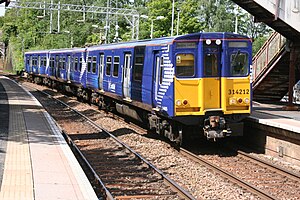British Rail Class 314
| British Rail Class 314 | |
|---|---|

ScotRail liveried Class 314 No. 314212 at Patterton
|
|
| In service | 1979-present |
| Manufacturer | British Rail Engineering Limited |
| Built at | BREL York |
| Family name | BREL 1972 "PEP" |
| Constructed | 1979 |
| Entered service | 26 October 1979 |
| Refurbishment | 2011-2013 |
| Number built | 16 trainsets |
| Formation | 3 cars per trainset DMSO+PTSO+DMSO |
| Fleet numbers | 314201 - 314216 |
| Capacity | 212 seats |
| Operator(s) | Abellio ScotRail |
| Depot(s) | Glasgow Shields Road TMD |
| Line(s) served |
Cathcart Circle Lines Inverclyde Line Paisley Canal Line |
| Specifications | |
| Car length | 19.80 m (64 ft 11 1⁄2 in) |
| Width | 2.82 m (9 ft 3 in) |
| Height | 3.58 m (11 ft 9 in) |
| Floor height | 1156 mm |
| Maximum speed | 75 mph (121 km/h) |
| Weight | 102.5 t (100.9 long tons; 113.0 short tons) |
| Power output | 656 kW (880 hp) |
| Electric system(s) | 25 kV 50 Hz AC Overhead |
| Track gauge | 1,435 mm (4 ft 8 1⁄2 in) standard gauge |
British Rail Class 314 alternating current (AC) electric multiple units (EMU) were built by BREL York works in 1979. They were the third variety of British Rail's then-standard 1972 design for suburban EMUs, which eventually encompassed 755 vehicles and five classes (Class 313/314/315/507/508). Able to operate from 25 kV overhead line only, the fleet works inner-suburban services on the Strathclyde rail network in Scotland.
Sixteen Class 314 3-car units were introduced in late 1979 to operate on the then newly opened Argyle Line and were used on both this and the North Clyde Line routes until 2002, when the scrapping of the elderly Class 303 stock led to much stock cascading within the Strathclyde transport network. The Class 314 was based on the experimental Class 445 or "PEP" unit, the design of which spawned the sister Class 313 and Class 315 units which are used extensively in the London commuter area.
In line with the other PEP-based classes, the Class 314 units consist of two outer motor cars with an unpowered trailer vehicle in the middle, giving a technical description of DMSO+PTSO+DMSO. The coaches are of integral aluminium alloy construction based on a steel underframe. Each 3-car set can seat up to 220 people, and following the standard practice in the Glasgow suburban sector, peak time services can be formed by operating two units in multiple to form a 6-car train.
...
Wikipedia
